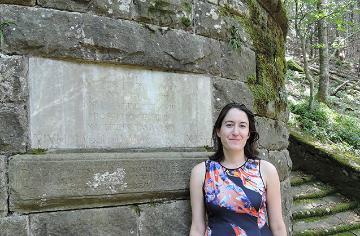
Classics Professor Taking Students to Italy for Inscription Fieldwork
From archaeology to iconography, for the past five summers Assistant Professor of Classics Carolynn Roncaglia has been on the hunt for Greek and Roman inscriptions throughout Northern Italy as part of a long-term project on the history of the Roman region.
And come August, five SCU students will be joining her to facilitate special imaging of the Roman inscriptions in the Western Alps’ Aosta Valley Great and Great St. Bernard Pass, where the dog breed of the same name originates.
“The SCU students will be using special imaging and photographic equipment for studying and cataloging the inscriptions to create an image database,” she says. The group will be working in tandem with a team from Stanford, who will primarily focus on the area’s exposed archeological remains.
For Roncaglia, working with inscriptions allows her to build social and cultural context around the actual words: “It's a way to look at both texts and objects and how the two intersect in monuments, ranging from small bronze dedications to large funerary monuments” she says. “These inscriptions represent a larger cross section of the society.”
Roncaglia’s team of SCU students will be arriving in the region with rich experience already in hand—four out of the five students have some knowledge of Latin, three have a working knowledge of Italian, and one student has even completed lichenometry work in Alaska, using lichen growth to determine the age of exposed rock.
Back in the classroom, Roncaglia loves to teach the Roman history sequence of courses whenever she can. However, this spring she’ll be teaching a new class on ancient science and technology, which she’s very much looking forward to.
“The new course looks at everything from Greek atomic theory to Roman cement and from Archimedes to magic,” she says, “so students will examine not just the classical origins of modern scientific disciplines but also cultures that are simultaneously familiar and alien.”
And for Roncaglia, the summer fieldwork allows her to keep classes like this up to date with new archaeological practices—particularly as they relate to digital humanities and cultural resource management.
“It’s good to incorporate the summer archeology experiences into this teaching,” she says, “and to introduce my students to ancient finds that are unpublished or not well known. That way, students get to see and analyze material that they wouldn't learn about in a textbook.”